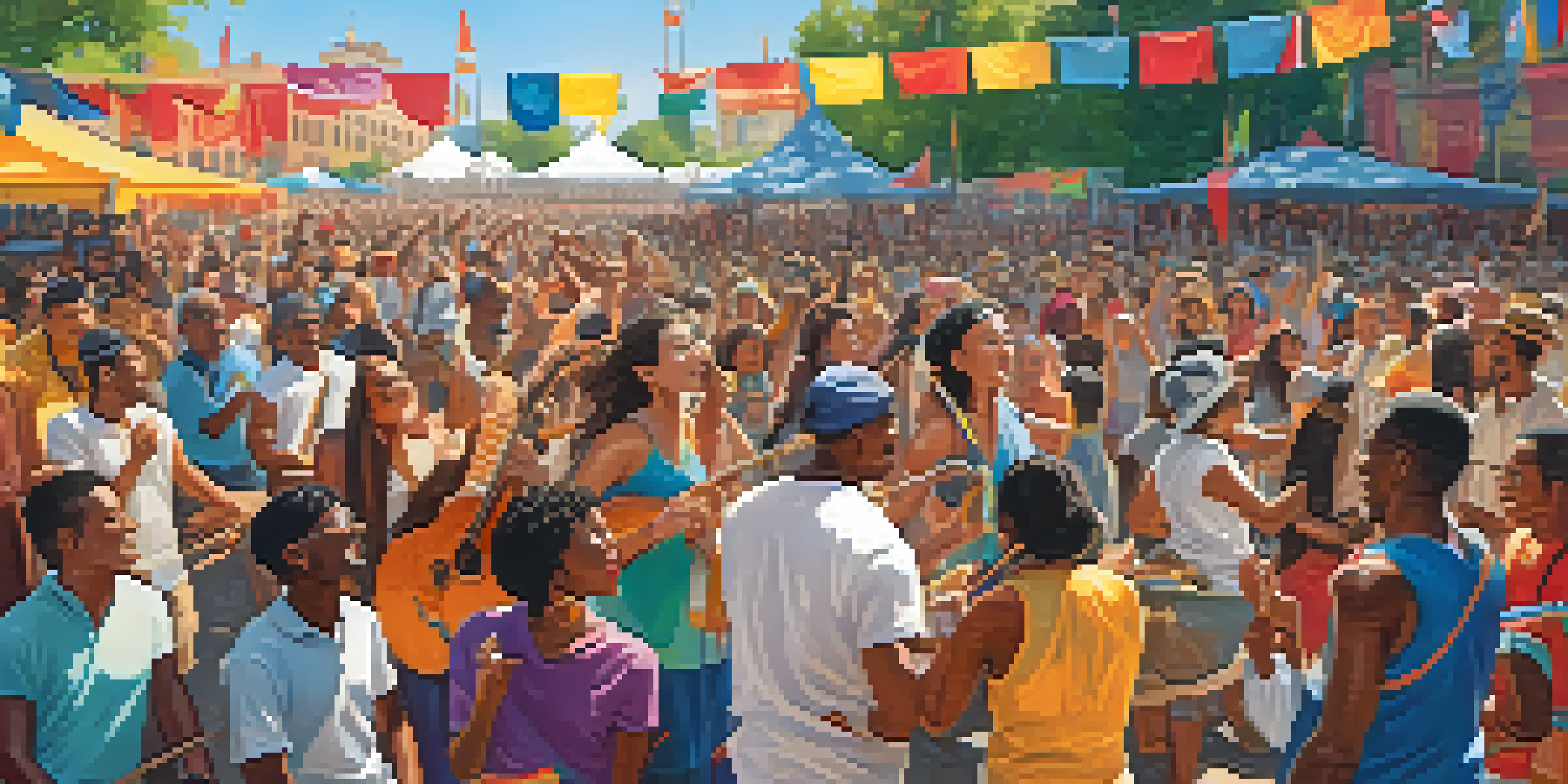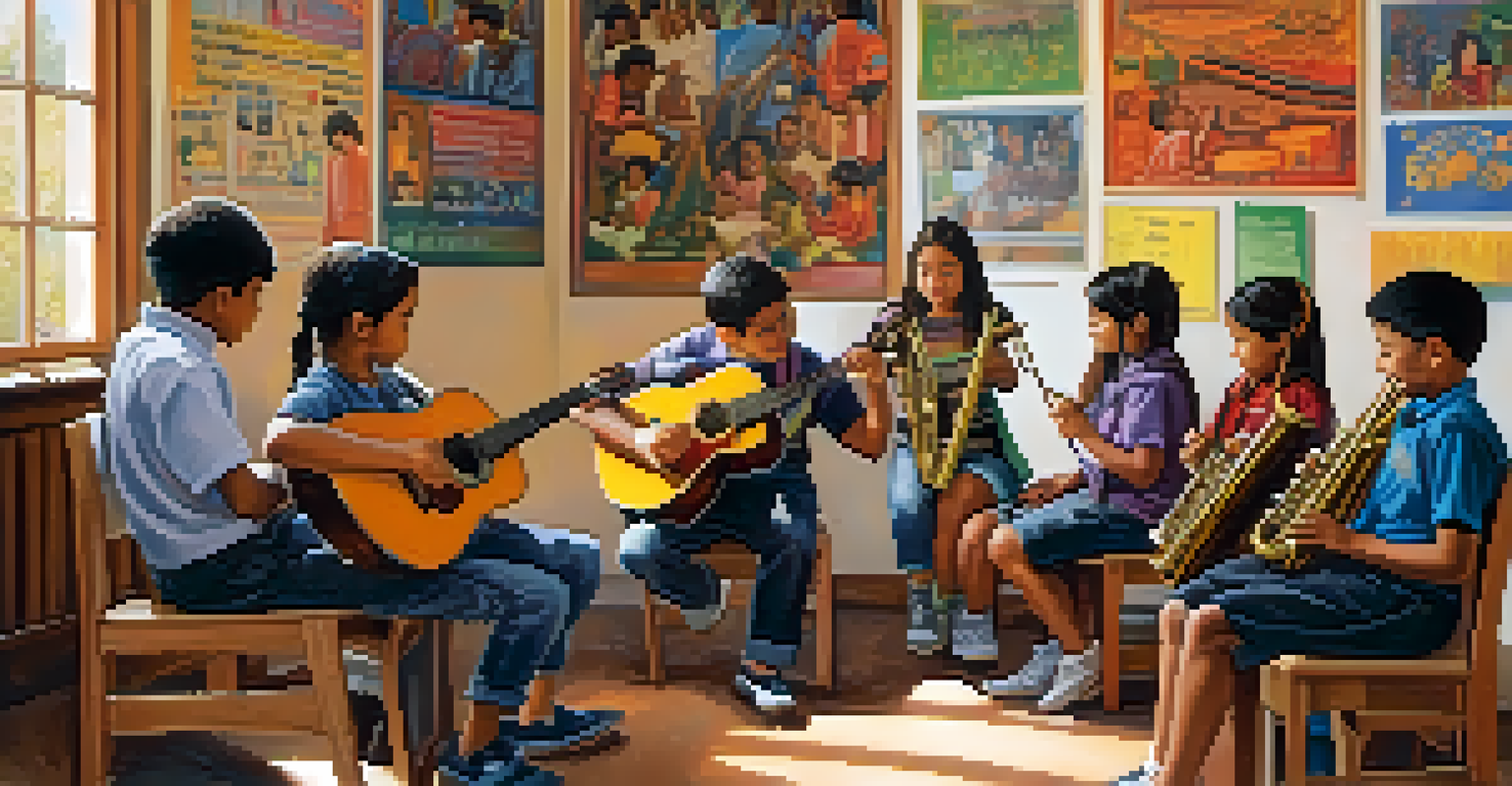Music's Role in Celebrating Community Diversity and Inclusion

Music as a Universal Language of Connection
Music transcends barriers of language and culture, connecting people on a fundamental level. Whether it's a catchy pop tune or a soulful ballad, the emotions conveyed through music resonate with everyone, regardless of their background. This universal language fosters connections, bringing together diverse groups in ways that words alone sometimes cannot.
Music can change the world because it can change people.
For example, think about a community concert where people from various cultures gather to share their music. Each performance showcases unique traditions, yet the joy and rhythm unite the audience, creating a shared experience. In this way, music acts as a bridge, allowing individuals to communicate and bond over their love for sound.
Ultimately, this connection through music creates a sense of belonging and community, reinforcing the idea that although we may come from different backgrounds, we all share similar joys and struggles. The melodies and harmonies we create together celebrate our shared humanity.
Cultural Representation Through Musical Genres
Different musical genres often reflect the cultures from which they originate, showcasing the rich diversity of human expression. Genres like reggae, hip-hop, and flamenco each tell stories rooted in their cultural backgrounds, allowing listeners to explore new perspectives. This representation is crucial in fostering understanding and appreciation for diverse communities.

For instance, hip-hop emerged from African American communities, providing a voice for social issues and cultural pride. As more people engage with this genre, they gain insight into the experiences and challenges faced by these communities, promoting empathy and awareness. In turn, this can lead to greater inclusivity and support for marginalized voices.
Music Connects Diverse Communities
Music transcends language barriers, fostering connections and a sense of belonging among people from different backgrounds.
By embracing various musical styles, we not only celebrate our differences but also find common ground. This cultural representation in music fosters a sense of pride among artists and listeners alike, reinforcing the idea that every community has something valuable to share.
The Power of Collaborative Music Projects
Collaborative music projects, such as community choirs or multicultural festivals, serve as powerful platforms for inclusion. These initiatives bring together musicians and non-musicians from various backgrounds, encouraging participants to share their unique styles and stories. As they collaborate, they learn from one another and build a sense of camaraderie.
Where words fail, music speaks.
Take, for example, a local festival featuring artists from different cultural backgrounds. Each performer showcases their traditional music while also collaborating with others to create something new and exciting. This fusion not only enriches the musical landscape but also fosters understanding and respect among diverse communities.
Through these collaborations, participants often form lasting friendships and connections that extend beyond the music itself. The shared experience of creating something beautiful together highlights the importance of unity and diversity in our communities.
Music Education as a Tool for Inclusion
Music education plays a vital role in promoting diversity and inclusion within communities. By introducing students to various musical traditions, educators can foster an appreciation for different cultures and encourage collaboration among peers. This foundation helps cultivate a more inclusive environment where everyone feels valued and heard.
For instance, schools that incorporate world music into their curriculum not only teach students about different cultures but also provide opportunities for them to participate in ensemble performances. These experiences allow students to explore diverse musical styles while developing teamwork and communication skills.
Cultural Expression in Music Genres
Musical genres reflect diverse cultural stories, promoting understanding and appreciation of various communities.
As students learn about the histories and contexts of various musical genres, they become more open-minded and empathetic towards others. Music education thus serves as a powerful vehicle for fostering inclusion and understanding in our increasingly diverse world.
Music Festivals Celebrating Diversity
Music festivals often serve as vibrant celebrations of diversity, bringing together artists from various backgrounds and cultures. These events showcase a wide range of musical styles, creating an inclusive atmosphere where attendees can experience the richness of global sounds. By promoting diverse lineups, festivals foster a sense of unity among participants.
For example, festivals like the Newport Folk Festival or the Global Citizen Festival not only highlight prominent artists but also emphasize emerging voices from underrepresented communities. This commitment to diversity ensures that attendees are exposed to a variety of perspectives, enriching their understanding of the world.
Ultimately, music festivals act as a microcosm of society, demonstrating how music can unite people from all walks of life. They remind us that our differences are what make us unique, and celebrating them together leads to a more harmonious community.
The Role of Music in Social Movements
Throughout history, music has played a crucial role in social movements, rallying people together for a common cause. Songs of protest and empowerment have inspired countless individuals to stand up for their rights and the rights of others, reinforcing the importance of unity in diversity. Music becomes a powerful tool for advocacy and change.
Consider the iconic anthems of the civil rights movement, like "We Shall Overcome" or Bob Dylan's "The Times They Are A-Changin'." These songs not only galvanized supporters but also provided a sense of hope and solidarity among those fighting for justice. They remind us that music can serve as a rallying cry for inclusivity.
Collaborative Music Builds Unity
Collaborative music projects create lasting connections among participants, highlighting the importance of diversity and inclusion.
By harnessing the power of music, social movements create a shared identity among participants, emphasizing that together, they can effect change. This highlights the vital role music plays in uniting diverse communities in the pursuit of equality and justice.
Creating Spaces for Music and Community Engagement
Creating spaces where music can thrive is essential for fostering community diversity and inclusion. Community centers, local venues, and even public parks can become hubs for musical expression, allowing people to come together and share their talents. These spaces encourage collaboration and creativity, making it easier for individuals from different backgrounds to connect.
For instance, open mic nights or jam sessions encourage local artists to share their music while promoting a sense of belonging. When people feel comfortable expressing themselves through music, they are more likely to engage with others and build relationships. This interaction can lead to a deeper understanding and appreciation of diverse cultures.

By prioritizing community engagement through music, we create an environment where everyone feels welcome. These inclusive spaces promote dialogue and connection, ultimately strengthening the social fabric of our communities.